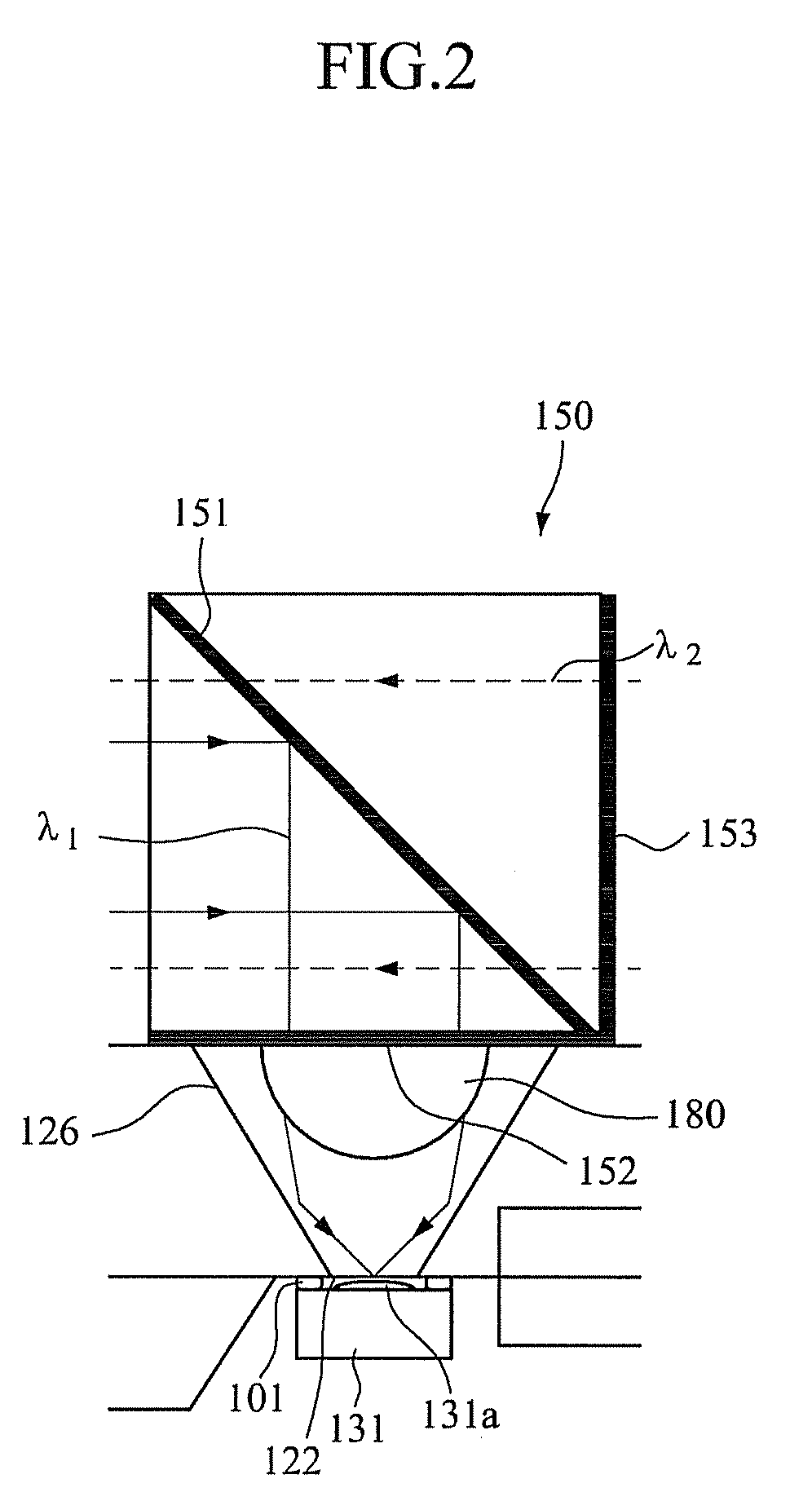Optical communication module
a communication module and optical communication technology, applied in the field of optical communication modules, can solve the problems of low production, low optical coupling efficiency, and severe optical/electrical crosstalk of conventional bidirectional optical transceiver modules thus configured, and achieve the effects of minimizing optical or electrical crosstalk, maximizing optical coupling efficiency, and reducing manufacturing costs
- Summary
- Abstract
- Description
- Claims
- Application Information
AI Technical Summary
Benefits of technology
Problems solved by technology
Method used
Image
Examples
first embodiment
[0035]FIG. 1 is a cross-sectional view of an optical communication module according to the present invention.
[0036]Referring to FIG. 1, an optical communication module 100 may transmit and receive light in both directions at the same time. The optical communication module 100 includes an optical line 110, a platform 120, an optical receiver 130, an optical transmitter 140, an optical filter 150 and an optical line focusing lens 160. The optical line focusing lens 160 may be mounted on a package rather than on the platform 120.
[0037]The optical line 110 may be an optical fiber or a stub for optical communication. The optical line 110 may receive light λ1 from outside and transmit it to the optical receiver 130. Further, the optical line 110 may receive light λ2 from the optical transmitter 140 and transmit it to the outside.
[0038]The platform 120 is provided at one side of the optical line 110. The platform 120 may partly have depressed and flat portions at its top and bottom surface...
second embodiment
[0061]FIG. 10 is a cross-sectional view of an optical communication module according to the present invention. Like reference numerals denote like elements and a detailed description thereof will thus be omitted herein.
[0062]Referring to FIG. 10, an optical communication module 200 is configured such that an optical line focusing lens 260 is provided between the light-emitting element 141 and the optical filter 150. The optical line focusing lens 260 focuses light from the light-emitting element 141 and transmits it to the optical line 110 through the optical filter 150. The optical line focusing lens 260 may be an aspheric lens as shown in FIG. 10. However, the optical line focusing lens 260 may be a ball lens or a half-ball lens and may be placed on a groove which is formed on the platform 120 as described above.
[0063]The optical filter 150 may be implemented in such ways as described above. For another example, the light-emitting element 141 may be provided on the bottom surface ...
third embodiment
[0064]FIG. 11 is a cross-sectional view of an optical communication module according to the present invention.
[0065]Referring to FIG. 11, an optical communication module 300 is configured in a triplexer form to make bidirectional communication with a single optical line 110.
[0066]The optical communication module 300 includes at least one additional through-hole 322 and one additional optical filter 350. Like the through-hole 122, the additional through-hole 322 is formed to vertically pass through the platform 120. The additional through-hole 322 is arranged next to the through-hole 122 in parallel with the direction of light input and output through the optical line 110. The additional through-hole 322 may have the same configuration as the through-hole 122.
[0067]The additional optical filter 350 is provided on the platform 120 to correspond to the additional through-hole 322. The additional optical filter 350 has a different wavelength pass band than the optical filter 150 which i...
PUM
 Login to View More
Login to View More Abstract
Description
Claims
Application Information
 Login to View More
Login to View More - R&D
- Intellectual Property
- Life Sciences
- Materials
- Tech Scout
- Unparalleled Data Quality
- Higher Quality Content
- 60% Fewer Hallucinations
Browse by: Latest US Patents, China's latest patents, Technical Efficacy Thesaurus, Application Domain, Technology Topic, Popular Technical Reports.
© 2025 PatSnap. All rights reserved.Legal|Privacy policy|Modern Slavery Act Transparency Statement|Sitemap|About US| Contact US: help@patsnap.com



